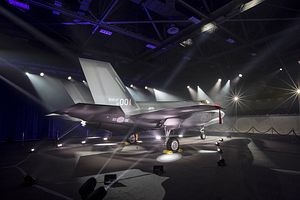U.S. defense firm Lockheed Martin rolled out the first F-35A Lightning II fifth-generation stealth fighter jet destined for the Republic of Korea Air Force (ROKAF) during a March 28 ceremony held at a Lockheed Martin production facility in Fort Worth, Texas, according to a company press release.
The ceremony was attended by a number of high-ranking U.S. and South Korean officials including members of the ROK National Assembly Defense Committee, Deputy Defense Minister Suh Coo-Suk. and the chief of the ROKAF air staff, Lieutenant General Lee Seong-Yong. U.S. attendees included the Undersecretary of Defense for Acquisition and Sustainment Heidi Grant and Deputy Undersecretary of the Air Force for International Affairs Vice Admiral Mat Winter.
“Today is a truly meaningful day as we celebrate the roll-out of ROKAF’s first F-35A, the world’s best fighter jet, which will secure the sovereign airspace of the Republic of Korea,” the Republic of Korea’s Minister of Defense Song Young-moo said in a previously recorded message. “The deployment of the F-35 will serve as momentum to enhance the combined operations of the ROK-U.S. Air Forces, and advance ROKAF’s support capabilities for ground operations.”
The F-35A is the fifth-generation stealth fighter’s multirole conventional takeoff and landing variant. South Korea and the U.S. signed a so-called Letter of Offer and Acceptance for the purchase of 40 F-35A fighter jets in September 2014 under the Pentagon’s Foreign Military Sales program. Total acquisition costs are estimated at around USD$7 billion. All forty aircraft are expected to be assembled at Lockheed Martin’s production facility in Fort Worth.
The first F-35A will be delivered to Luke Air Force Base, Arizona, where ROKAF pilots and maintainers will begin training on the aircraft. The first F-35A will arrive in South Korea in 2019. The entire delivery is expected to be completed by 2021 (possibly 2022). The aircraft will be stationed at Cheong Ju airbase. As I explained previously:
Lockheed Martin, the aircraft maker producing the F-35 series, won the [USD$6.8] billion defense deal by promising to provide 25 technologies associated with the F-35 to help kick start South Korea’s KF-X fighter aircraft program. The objective of the $15 billion KF-X fighter program is to build 120 stealth fighter jets for the ROK Air Force and another 80 for the Indonesia Air Force (TNI-AU) between 2025 and 2030. However, the United States refused to share four (active electronically scanned radar, the infrared search-and-rescue systems, the electro-optical targeting pod and the radio frequency jammer) out of the 25 technologies.
Instead, South Korea has opted to produce locally-made replacements of the four systems. Initial fears that South Korea would pull out of the F-35A deal as a result proved unfounded. As I reported in December 2017, South Korea’s Defense Acquisition Program Administration (DAPA) has purportedly initiated the acquisition process for an additional F-35As. The F-35A stealth fighter will be an integral part of South Korea’s so-called Kill-Chain pre-emptive strike program, an integral part of the government’s Korea Massive Punishment & Retaliation deterrence strategy to deter North Korean aggression.

































